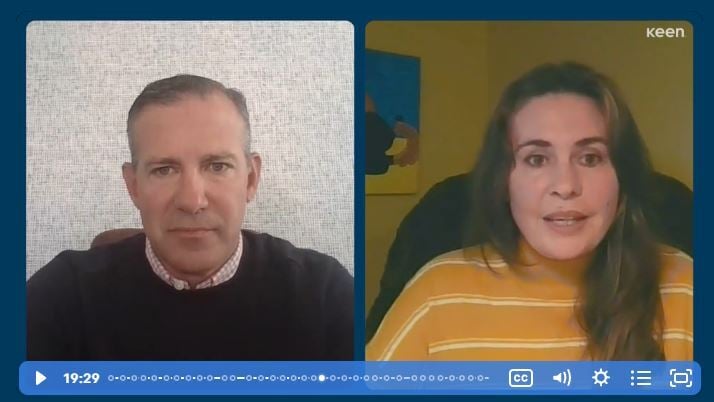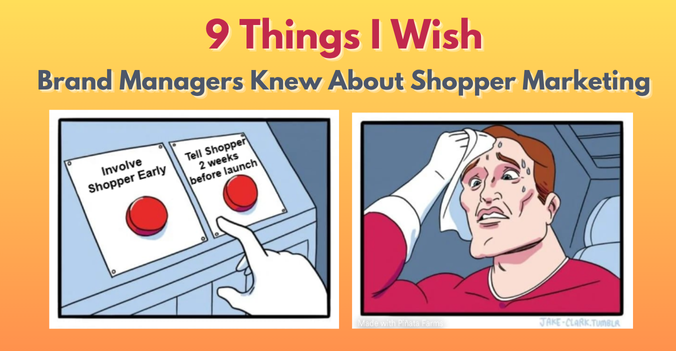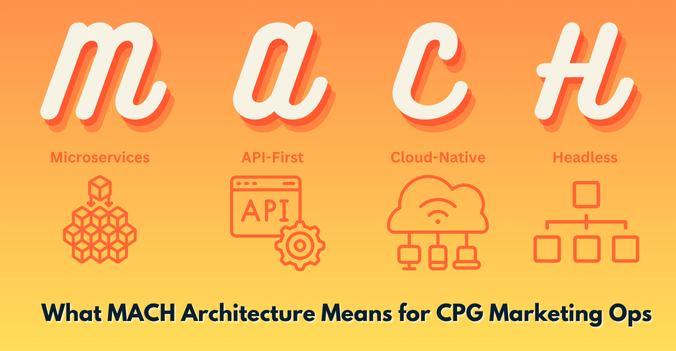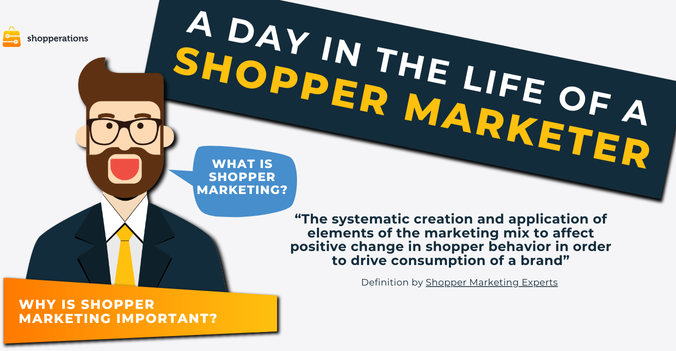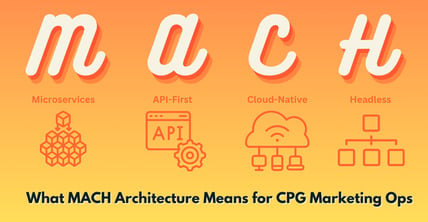
You may have heard IT or digital transformation teams mention something called MACH architecture. It sounds technical, maybe even intimidating, but it’s a concept that CPG marketers should get excited about.
MACH stands for Microservices, API-first, Cloud-native, and Headless. These are software design principles that, when applied well, lead to systems that are more agile, easier to integrate, and better aligned with how modern teams work.
In this article, I’ll break down what each MACH component means in plain terms, why it matters for marketing operations, and show specific examples how platforms like Shopperations help bring these principles to life, without requiring you to be a developer or architect.
Why Marketers Should Care About MACH
Historically, CPG marketers have had to work around rigid, outdated systems that were built for other user personas, or even worse: rely on spreadsheets to track budgets, plans, and performance. MACH architecture represents a shift toward flexibility and control, making it easier to:
- Integrate with other teams and systems
- Adapt to new channels and tactics quickly
- Collaborate in real time, without duplicate trackers
- Get cleaner data and faster reporting
But even more importantly, understanding MACH helps marketers speak the same language as IT and Finance, which leads to better alignment and stronger support when it comes to selecting and implementing software tools.
Let’s break it down.
Microservices: Small Parts That Work Together
What it means:
Instead of building one big, inflexible system, microservices architecture breaks functionality into smaller, specialized components that can operate independently.
Why it matters to you:
This means your software can evolve in pieces without disrupting the whole system. New capabilities can be added or improved gradually, based on your needs.
In Shopperations:
Budgets and tactical planning are our core modules. Additional features like invoice & deductions reconciliation, coupon actualization, and sales tracking can be turned on as needed. You get a tailored system, not a one-size-fits-all overload.
API-First: Letting Systems Talk to Each Other
What it means:
An API (Application Programming Interface) is a way for software systems to connect and share data automatically.
Why it matters to you:
Instead of exporting and reformatting data manually, APIs let your marketing system feed information directly into dashboards, finance tools, TPM systems or analytics platforms. It eliminates double work and improves visibility.
In Shopperations:
Our Reports API lets clients pull real-time data into internal data lakes, dashboards, or email workflows. Agencies and IT teams can automate tasks like coupon reconciliation or post-event reporting — saving time and reducing errors.
Cloud-Native: Accessible, Scalable, Secure
What it means:
Cloud-native software lives on the internet — not on individual desktops or company servers. It scales easily, updates automatically, and can be accessed from anywhere.
Why it matters to you:
You don’t need IT to install anything. You get new features faster. Support is simpler, and security is handled at the platform level.
In Shopperations:
We’ve been fully SaaS and hosted on Microsoft Azure from day one. Users log in through a browser. Nothing to install, nothing to patch, no version confusion.
Headless: Data That Travels Beyond the UI
What it means:
Headless architecture separates the front-end interface (what users see) from the back-end data and logic. This allows teams to present the same data in multiple formats or interfaces.
Why it matters to you:
You might want to use the same data from your marketing plans in a Power BI media performance dashboard, load it into a TPM system to enable a fully loaded customer P&L, into a finance system during the period close, or as model inputs in a marketing mix study, without re-entering it.
In Shopperations:
Reports API and Excel Add-In give your data freedom to flow where it’s needed. We’re not just a place to enter data, we’re a source of truth that feeds other parts of your business.
What This Means for Your Role as a Marketer
You don’t need to be a MACH expert. But by understanding the basics, you can:
- Ask smarter questions when evaluating new tools
- Collaborate more effectively with IT and Finance
- Advocate for solutions that empower your team and reduce manual work
- Move away from spreadsheets without sacrificing control or flexibility
When you ask, “Does this tool support API access?” or “Can we turn off modules we don’t need yet?” you’re not just being tech-savvy, you’re protecting your team’s efficiency and futureproofing your marketing operations.
How Shopperations Helps You Embrace MACH, Without the Overhead
We didn’t build Shopperations to check a technology box. We built it to solve a real problem: how CPG marketers can plan, manage, and actualize omnichannel spend in a transparent, scalable way.
That said, MACH principles are baked into how our platform works:
- Modular components that can be toggled based on your team’s needs
- Real-time API access and Excel integration for reporting flexibility
- Cloud-native, secure deployment on Azure
- A data model designed to serve marketers, not force them to adapt to IT systems
The result? You get the benefits of MACH without needing to rip and replace your existing workflow, and without overwhelming your team with unnecessary features.
Final Thoughts: Speak the Language of the Future
Marketing operations discipline is becoming more strategic, more technical, and more connected to enterprise planning. Learning the language of MACH is a small investment that pays off in credibility, alignment, and better outcomes.
At Shopperations, we’re proud to support this evolution — not by forcing you to become technologists, but by giving you tools that work the way modern systems should.
If you want to explore how MACH-ready your marketing operations are, we’re here to help.
Other Posts You May Like:
Shopper Marketing Operations Manager Job Description
HOW TO CALCULATE SHOPPER MARKETING ROI
8 features of a great Shopper Marketing Plan



